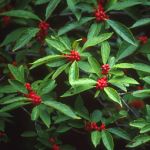| Common Name: |
Winterberry |
| Other Names: |
Black Alder |
| Botanical Name: |
Ilex verticillata syn. Prinos verticillatus |
| Genus: |
Ilex |
| Family: |
Aquifoliaceae |
| Native Location: |
N America |
| Cultivation: |
Moist, well-drained soil in sun or shade. Variegated hollies need sun for optimum color. Ilex verticillata tolerates wet conditions. Cut back or trim in spring; clip formal specimens in summer. Prune I. paraquariensis into a low bush for ease of harvesting in the same way as tea (Camellia sinensis, See tea). Leaves may be damaged by holly leaf miner or leafspot. Transplant or repot with the root ball intact. |
| Propagation: |
By seed sown in autumn (species only); by semi-ripe cuttings in late summer or autumn. |
| Harvest: |
Leaves are picked in early summer (I aquifolium) and dried for infusions and liquid extracts. Leafy shoots (I. paraguarensis) may be picked at intervals throughout the year, in the same way as tea, and dried for infusions. Bark is peeled from twigs of I. verticillata in spring and dried for use in decoctions and liquid extracts. |
| Height: |
2-5m (6-15ft) |
| Width: |
1.2-3m (4-10ft) |
| Hardiness: |
Z3-7 |
| Parts Used: |
Bark |
| Properties: |
A bitter, astringent, antiseptic herb that has tonic and laxative effects. |
| Medicinal Uses: |
Internally for fevers, hepatitis, and jaundice. Externally for skin inflammations, herpes, and gangrenous ulcers. Combined with Ulmus rubra (See, slippery elm) for skin problems. |
| Warning: |
Berries are harmful if eaten. |
| Bibliography: |
Encylopedia of Herbs by Deni Brown Copyright ©: 1995, 2001 Dorling Kindersley Limited pg 241-242
|

